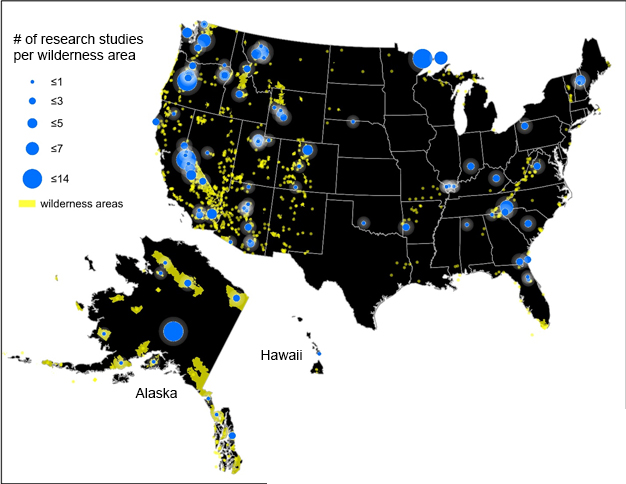Wilderness and Science
Wilderness is a critical place for scientific discovery and community participation

Science in Wilderness
Science, both inside and outside wilderness, helps us understand how to prevent impacts from visitors, how fire changes the land over time, the benefits of protecting land to local economies, and much more. Science is essential to wilderness, but wilderness is also essential to science. Wilderness designation confers long-term protection of relatively large landscapes, which provide the premier backdrop for social and ecological research.
Surges in outdoor recreation have led researchers to further study wilderness visitors. A review conducted by the University of Montana found that most science conducted over the past several decades occurred in a small number of high-profile wilderness areas, while 89% of the wilderness system remains unstudied. This map, published in the International Journal of Wilderness December 2021 issue and credited to William Rice with the University of Montana, Parks, Tourism and Recreation Management program, shows the geographic distribution of wilderness science.

The map below shows select scientific studies from the Aldo Leopold Wilderness Research Institute by category (expand the legend). Click on a study area to read more about the study and its significance. Search the Leopold Institute's publications for more on their wilderness science program.
Wilderness and Science
Wilderness and Climate Science
Through a case study of climate change research in the Kenai Wilderness in Alaska, this video discusses the importance of wilderness to climate science, and the importance of climate science findings to future wilderness stewardship.
Wild Science: Wilderness and Climate Change
Community Science in Wilderness
Every person has the power to collect truly robust data. The map below shows the size and location of different weeds--invasive species that can take over entire natural areas. The weeds are mapped by Montana volunteers through the Wilderness Institute's Citizen Science Program. Between 2005 and 2021, the Wilderness Institute has enlisted more than 600 volunteers. Volunteers have ranged in age from 9 to 75, and some like 11-season veteran Steve Ford , come back year after year. The data volunteers collect are used by wilderness managers to determine vectors of infestation, like trails, and treatment actions.
Although many types of science take place in wilderness, climate change is an increasing area of focus that presents new challenges for preserving the wild character of wilderness.
Weeds in the Welcome Creek Wilderness